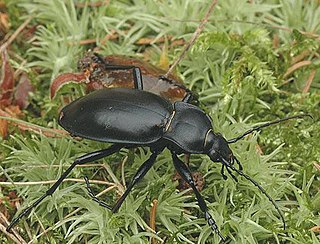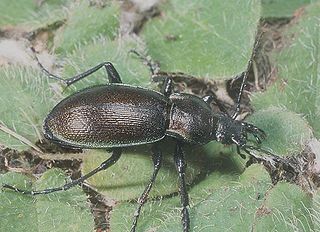
Pinus sylvestris, the Scots pine (UK), Scotch pine (US), Baltic pine, or European red pine is a species of tree in the pine family Pinaceae that is native to Eurasia. It can readily be identified by its combination of fairly short, blue-green leaves and orange-red bark.

Pierre François Marie Auguste Dejean, was a French soldier and entomologist. Dejean described a large number of beetles in a series of catalogues.
Georg Wolfgang Franz Panzer was a German botanist and entomologist.

Dolichovespula is a small genus of social wasps distributed widely throughout the Northern Hemisphere. The yellow and black members of the genus are known by the common name yellowjackets in North America, such as Dolichovespula norwegica, along with members of their sister genus Vespula. In a study on the nesting biology of Dolichovespula, a colony of D. maculata with 771 workers was reported as having the largest recorded population count.

Carabus is a genus of beetles in family Carabidae. The genus is highly diverse with 94 subgenera, 959 species and 2300 subspecies, thus is the largest genus in the subfamily Carabinae. The vast majority are native to the Palearctic, but 16 Nearctic species are also known. Carabus spp. are 12–50 mm (0.47–1.97 in) long, and most species are wingless and often very colourful. These are nocturnal, predatory beetles that feed on snails, earthworms, and caterpillars. Most Carabus species were thought to have inhabited the Eurasian forest, but the species' low dispersal abilities altered the distribution of lineages within the genus.

Carabus scheidleri is a species of beetle. It is endemic to Europe, where it is found in Austria, the Czech Republic, Germany, Hungary, Liechtenstein, Poland, Slovakia,.

Carabus smaragdinus is a species of beetle belonging to the family Carabidae.

Carabus linnei is a species of ground beetle in the family Carabidae. It is found in Europe.

Alexiidae is a family of beetles. It contains a single genus, Sphaerosoma, formerly included within the family Cerylonidae, with around 50 species which are native to the western Palearctic. Species of Sphaerosoma are very small, around 1 to 2 mm in length rounded beetles with clubbed antennae. They are fungivores, having been observed feeding on mushrooms, and have also been found in leaf litter and on decaying bark.

Carabus sylvestris is a species of either black or brown-coloured ground beetle in the Carabinae subfamily that can be found in Austria, Czech Republic, Hungary, Italy, Liechtenstein, Poland, Romania, Slovakia, Slovenia, Ukraine, and the Netherlands.

Carabus sylvestris transsylvanicus is a subspecies of green-coloured beetle in the family Carabidae that can be found in Hungary, Liechtenstein, Poland, Romania, and Slovakia.
Carabus sylvestris redtenbacheri is a subspecies of beetle in the family Carabidae that is endemic to Austria.
Carabus sylvestris kolbi is a subspecies of beetle in the family Carabidae that can be found in Austria and Slovenia.
Carabus sylvestris haberfelneri is a subspecies of beetle in the family Carabidae that can be found in Austria and Germany.

Saddington Reservoir is a canal reservoir and 19.1 hectares biological Site of Special Scientific Interest south of Saddington in Leicestershire. The reservoir was built between 1793 and 1797 to supply water to the Grand Union canal.

Trachusa byssina is a species of bees within the genus Trachusa.











